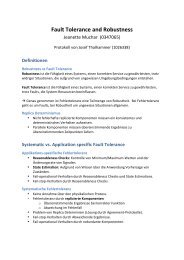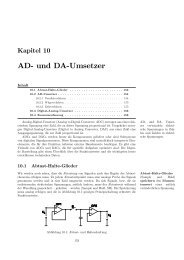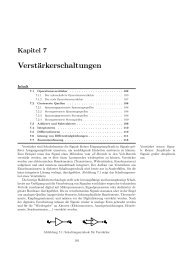- Page 1 and 2: Introduction to Microcontrollers Co
- Page 3 and 4: 2.7.2 Power Consumption and Sleep .
- Page 6 and 7: Preface This text has been develope
- Page 10 and 11: 4 CHAPTER 1. MICROCONTROLLER BASICS
- Page 12 and 13: 6 CHAPTER 1. MICROCONTROLLER BASICS
- Page 14 and 15: 8 CHAPTER 1. MICROCONTROLLER BASICS
- Page 16 and 17: 10 CHAPTER 1. MICROCONTROLLER BASIC
- Page 18 and 19: 12 CHAPTER 2. MICROCONTROLLER COMPO
- Page 20 and 21: 14 CHAPTER 2. MICROCONTROLLER COMPO
- Page 22 and 23: 16 CHAPTER 2. MICROCONTROLLER COMPO
- Page 24 and 25: 18 CHAPTER 2. MICROCONTROLLER COMPO
- Page 26 and 27: 20 CHAPTER 2. MICROCONTROLLER COMPO
- Page 28 and 29: 22 CHAPTER 2. MICROCONTROLLER COMPO
- Page 30 and 31: 24 CHAPTER 2. MICROCONTROLLER COMPO
- Page 32 and 33: 26 CHAPTER 2. MICROCONTROLLER COMPO
- Page 34 and 35: 28 CHAPTER 2. MICROCONTROLLER COMPO
- Page 36 and 37: 30 CHAPTER 2. MICROCONTROLLER COMPO
- Page 38 and 39: 32 CHAPTER 2. MICROCONTROLLER COMPO
- Page 40 and 41: 34 CHAPTER 2. MICROCONTROLLER COMPO
- Page 42 and 43: 36 CHAPTER 2. MICROCONTROLLER COMPO
- Page 44 and 45: 38 CHAPTER 2. MICROCONTROLLER COMPO
- Page 46 and 47: 40 CHAPTER 2. MICROCONTROLLER COMPO
- Page 48 and 49: 42 CHAPTER 2. MICROCONTROLLER COMPO
- Page 50 and 51: 44 CHAPTER 2. MICROCONTROLLER COMPO
- Page 52 and 53: 46 CHAPTER 2. MICROCONTROLLER COMPO
- Page 54 and 55: 48 CHAPTER 2. MICROCONTROLLER COMPO
- Page 56 and 57: 50 CHAPTER 2. MICROCONTROLLER COMPO
- Page 58 and 59:
52 CHAPTER 2. MICROCONTROLLER COMPO
- Page 60 and 61:
54 CHAPTER 2. MICROCONTROLLER COMPO
- Page 62 and 63:
56 CHAPTER 2. MICROCONTROLLER COMPO
- Page 64 and 65:
58 CHAPTER 2. MICROCONTROLLER COMPO
- Page 66 and 67:
60 CHAPTER 2. MICROCONTROLLER COMPO
- Page 68 and 69:
62 CHAPTER 2. MICROCONTROLLER COMPO
- Page 70 and 71:
64 CHAPTER 2. MICROCONTROLLER COMPO
- Page 72 and 73:
66 CHAPTER 2. MICROCONTROLLER COMPO
- Page 74 and 75:
68 CHAPTER 2. MICROCONTROLLER COMPO
- Page 76 and 77:
70 CHAPTER 2. MICROCONTROLLER COMPO
- Page 78 and 79:
72 CHAPTER 2. MICROCONTROLLER COMPO
- Page 80 and 81:
74 CHAPTER 3. COMMUNICATION INTERFA
- Page 82 and 83:
76 CHAPTER 3. COMMUNICATION INTERFA
- Page 84 and 85:
78 CHAPTER 3. COMMUNICATION INTERFA
- Page 86 and 87:
80 CHAPTER 3. COMMUNICATION INTERFA
- Page 88 and 89:
82 CHAPTER 3. COMMUNICATION INTERFA
- Page 90 and 91:
84 CHAPTER 3. COMMUNICATION INTERFA
- Page 92 and 93:
86 CHAPTER 3. COMMUNICATION INTERFA
- Page 94 and 95:
88 CHAPTER 3. COMMUNICATION INTERFA
- Page 96 and 97:
90 CHAPTER 4. SOFTWARE DEVELOPMENT
- Page 98 and 99:
92 CHAPTER 4. SOFTWARE DEVELOPMENT
- Page 100 and 101:
94 CHAPTER 4. SOFTWARE DEVELOPMENT
- Page 102 and 103:
96 CHAPTER 4. SOFTWARE DEVELOPMENT
- Page 104 and 105:
98 CHAPTER 4. SOFTWARE DEVELOPMENT
- Page 106 and 107:
100 CHAPTER 4. SOFTWARE DEVELOPMENT
- Page 108 and 109:
102 CHAPTER 4. SOFTWARE DEVELOPMENT
- Page 110 and 111:
104 CHAPTER 4. SOFTWARE DEVELOPMENT
- Page 112 and 113:
106 CHAPTER 4. SOFTWARE DEVELOPMENT
- Page 114 and 115:
108 CHAPTER 4. SOFTWARE DEVELOPMENT
- Page 116 and 117:
110 CHAPTER 4. SOFTWARE DEVELOPMENT
- Page 118 and 119:
112 CHAPTER 4. SOFTWARE DEVELOPMENT
- Page 120 and 121:
114 CHAPTER 4. SOFTWARE DEVELOPMENT
- Page 122 and 123:
116 CHAPTER 4. SOFTWARE DEVELOPMENT
- Page 124 and 125:
118 CHAPTER 4. SOFTWARE DEVELOPMENT
- Page 126 and 127:
120 CHAPTER 4. SOFTWARE DEVELOPMENT
- Page 128 and 129:
122 CHAPTER 4. SOFTWARE DEVELOPMENT
- Page 130 and 131:
124 CHAPTER 4. SOFTWARE DEVELOPMENT
- Page 132 and 133:
126 CHAPTER 4. SOFTWARE DEVELOPMENT
- Page 134 and 135:
128 CHAPTER 4. SOFTWARE DEVELOPMENT
- Page 136 and 137:
130 CHAPTER 5. HARDWARE A somewhat
- Page 138 and 139:
132 CHAPTER 5. HARDWARE This effect
- Page 140 and 141:
134 CHAPTER 5. HARDWARE B A (a) A B
- Page 142 and 143:
136 CHAPTER 5. HARDWARE e a f g d F
- Page 144 and 145:
138 CHAPTER 5. HARDWARE new value f
- Page 146 and 147:
140 CHAPTER 5. HARDWARE Relays come
- Page 148 and 149:
142 CHAPTER 5. HARDWARE N S N S Fig
- Page 150 and 151:
144 CHAPTER 5. HARDWARE motor speed
- Page 152 and 153:
146 CHAPTER 5. HARDWARE A B UM moto
- Page 154 and 155:
148 CHAPTER 5. HARDWARE requires a
- Page 156 and 157:
150 CHAPTER 5. HARDWARE Half- and m
- Page 158 and 159:
152 CHAPTER 5. HARDWARE Stepper Mot
- Page 160 and 161:
154 CHAPTER 5. HARDWARE
- Page 162 and 163:
156 APPENDIX A. TABLE OF ACRONYMS E
- Page 164 and 165:
158 APPENDIX A. TABLE OF ACRONYMS T
- Page 166 and 167:
160 INDEX Ankerspule (armature coil
- Page 168 and 169:
162 INDEX Embedded Processor, 7 Emb
- Page 170 and 171:
164 INDEX non-volatile RAM, 29 NVRA
- Page 172 and 173:
166 INDEX source input, 38 source o
- Page 174 and 175:
168 INDEX













